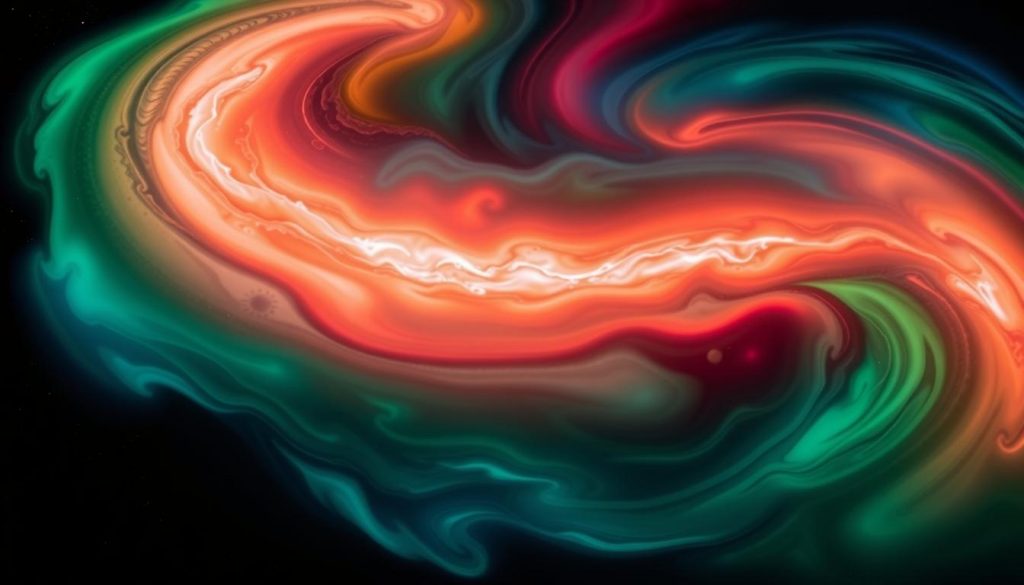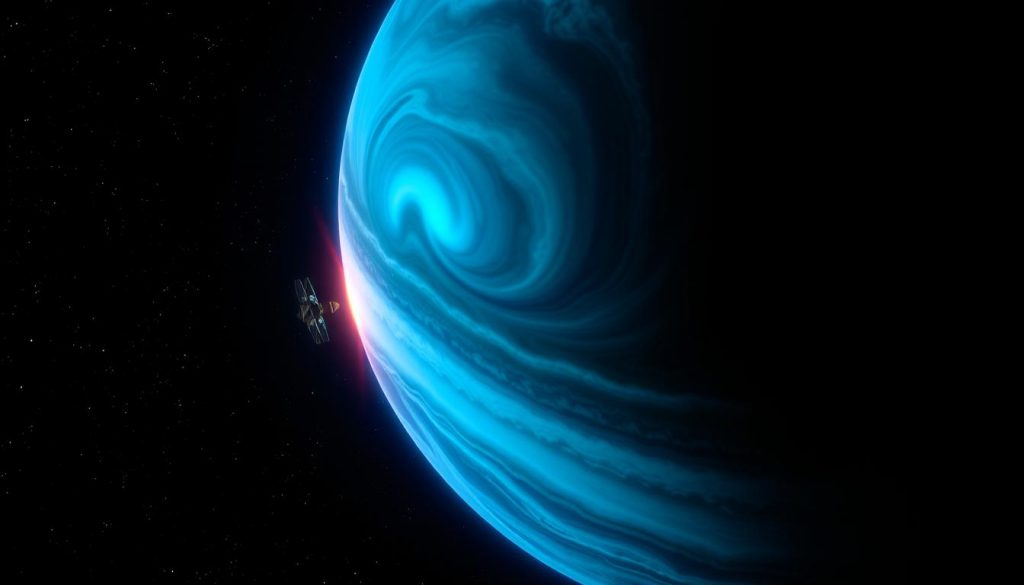Jupiter’s Auroras: Stunning Light Shows on the Gas Giant
Jupiter, the largest planet in our solar system, has breathtaking light shows called Jupiter auroras. These light displays happen when high-energy particles hit the planet’s atmosphere near its magnetic poles. This creates brilliant arcs of light that are both beautiful and important for science.
Anúncios
Unlike Earth’s occasional auroras, Jupiter’s are always active. They release energy hundreds of times more than Earth’s. This makes Jupiter’s auroras truly unique.
The Hubble Space Telescope is key to understanding these light shows. It uses far-ultraviolet-light imaging to observe Jupiter almost every day. The areas affected by Jupiter’s auroras are bigger than Earth, showing how vast these cosmic displays are.
Thanks to Hubble and the Juno spacecraft, scientists can study Jupiter’s auroras and solar wind together. Juno entered Jupiter’s orbit in July 2016. This collaboration helps us learn more about Jupiter’s dynamic and beautiful environment.
The Beauty of Jupiter’s Auroras
Jupiter’s auroras are a breathtaking sight for astronomers and fans. These cosmic light shows are unlike anything seen on Earth. They display vibrant, swirling patterns in Jupiter’s upper atmosphere.
Unlike Earth’s auroras, which we can see, Jupiter’s are mostly ultraviolet. This makes them invisible to us, but still mesmerizing.
The auroras on Jupiter pulse every 11 minutes at the poles. Each hot spot is huge, covering half the size of Earth’s surface. This shows the powerful forces at work in Jupiter’s atmosphere, linked to its strong magnetic field.
Thanks to XMM-Newton, we now know more about Jupiter’s auroras. NASA’s Juno spacecraft started its mission in 2016. It helps us watch the auroras in real-time and gather data.
New discoveries show auroras around Jupiter’s moons, Io and Europa. Io’s volcanic atmosphere and Jupiter’s magnetic field are key to these findings. Scientists need global help to study these events, using telescopes in Hawaii, Arizona, and New Mexico.
ESA’s Juice mission is coming in 2029. It will explore Jupiter’s atmosphere and auroras further. Jupiter’s auroras are not just beautiful. They help us understand Jupiter’s complex environment.
How Jupiter’s Auroras Are Formed
Jupiter’s auroras are amazing sights caused by charged particles and strong magnetic fields. These particles come from the solar wind and Io’s volcanoes. Io, with over 400 volcanoes, releases a lot of sulfur and oxygen ions.
These ions mix with solar particles, creating a lively scene in Jupiter’s magnetosphere.
The making of Jupiter’s auroras is very energetic. Unlike Earth, Jupiter’s auroras come from Io’s ion emissions. Jupiter’s magnetic field stretches far into space, leading to beautiful lights.
The tug-of-war dynamic between Jupiter’s magnetic field and Io’s space-lava plasma forms a crucial aspect of aurora formation.
Jupiter’s X-ray auroras flash every 27 minutes, showing their huge power. They are much brighter than Earth’s and can produce as much energy as all of humanity uses. This is because Jupiter’s magnetic fields are incredibly strong.
The mix of charged particles from Io and Jupiter’s magnetic fields creates stunning auroras. These lights are over 1,000 times brighter than Earth’s. The Juice mission in 2029 will help scientists learn more about these amazing lights.
Nasa’s Hubble Space Telescope: A Key Player
The NASA/ESA Hubble Space Telescope is crucial in uncovering Jupiter’s aurora secrets. It uses advanced ultraviolet tech for precise aurora observations. This lets scientists see the amazing energy bursts from these light shows.
Each auroral event releases hundreds of gigawatts of energy. This shows how powerful these events are.
This research aims to understand how Jupiter’s auroras react to space weather changes. The solar wind’s charged particles interact with Jupiter’s magnetic field. This interaction causes auroras every 27 minutes through electromagnetic ion cyclotron (EMIC) waves.
This shows why Hubble’s data is key to studying these striking phenomena.

Hubble looks beyond just visible light; it also studies X-rays from Jupiter’s auroras. Missions like NASA’s Chandra and the ESA’s XMM-Newton help too. By analyzing these energy releases, Hubble has shed light on how Jupiter’s auroras work compared to other gas giants.
Over 40 years, data has revealed much about these celestial displays. It shows that similar auroral processes might happen around Saturn, Uranus, and Neptune. This broadens our view of the solar system’s magnetic interactions.
Thanks to Hubble, we continue to learn about Jupiter’s mysterious auroras. It helps us understand their role in the cosmos.
Jupiter Auroras: Scope and Scale
Jupiter’s auroras are much bigger and brighter than Earth’s. They cover vast areas, showing off incredible energy. Unlike Earth’s, Jupiter’s auroras are always on, revealing its unique atmosphere.
Jupiter’s magnetosphere is key to its auroras. It gets charged with sulfur and oxygen ions, making the lights even more intense. Scientists find Jupiter’s auroras have much higher energy levels than Earth’s.
Compared to Earth, Jupiter’s auroras are more powerful and steady. The way Jupiter’s plasma moves creates complex magnetic fields. This makes Jupiter’s magnetosphere very different from Earth’s, offering scientists a lot to study.
The Science Behind Aurora Tracking
Tracking auroras is a mix of scientific methods and advanced imaging. The Hubble Space Telescope has captured amazing images of Jupiter’s auroras since 1990. With the new Space Telescope Imaging Spectrograph (STIS), researchers can see more clearly than ever before.
The STIS makes images 2 to 5 times clearer. This helps scientists study auroras that reach high above Jupiter. They can now see how these lights change, helping them understand space weather better.
Jupiter’s auroras are different from Earth’s. They are mostly caused by Jupiter’s moon Io, not the solar wind. The auroras at Jupiter’s poles show colors like brown, white, blue, and red, thanks to sunlight and emissions.
Data analysis is key to learning more about these big lights. Jupiter’s X-ray auroras pulse every 27 minutes. Scientists have studied them for over 40 years since Voyager 1 found them in 1979.
By tracking auroras, we might learn about other planets too. This research helps us understand not just Jupiter but the whole universe.
| Feature | Jupiter’s Auroras | Earth’s Auroras |
|---|---|---|
| Cause | Charged particles from Io | Solar wind |
| Location | North and south magnetic poles | Belt surrounding magnetic poles |
| Size | Larger than Earth | Varies based on solar activity |
| Unique Feature | Emits X-rays | Emits visible light |
| Pulsation Period | Every 27 minutes | Variable based on conditions |
Juno Spacecraft’s Role in Aurora Research
The Juno spacecraft is a key part of NASA’s Jupiter mission. It arrived on July 5, 2016, and has changed how we see Jupiter’s auroras. Juno has special tools to study Jupiter’s magnetic field, which is much stronger than Earth’s.
Juno’s findings show how Jupiter’s magnetic field affects its auroras. The field starts to deflect solar wind 2-4 million miles from Jupiter. This shows its huge impact. Juno’s ultraviolet spectrograph has found new details about Jupiter’s auroras.

Juno has found that Jupiter’s upper atmosphere can get up to 800 degrees Fahrenheit. This heat helps create some of the strongest auroras in our solar system. Most auroras come from inside the planet, like charged particles moving in the magnetosphere.
The Juno mission is set to run until 2025. It orbits Jupiter every 53 days, capturing images of powerful auroras. These studies help us understand Jupiter and other planets’ auroras better.
| Parameter | Value |
|---|---|
| Magnetic Field Strength | 20,000 times stronger than Earth’s |
| Dist. Solar Wind Begins to Deflect | 2–4 million miles |
| Juno Arrival Date | July 5, 2016 |
| Fastest Rotation Period | Approximately 10 hours |
| Measured Atmospheric Temp. | 800 degrees Fahrenheit (426 degrees Celsius) |
| Extended Mission Approval | Until 2025 |
| Auroral Ring Forming Processes | Kelvin-Helmholtz instabilities, magnetic reconnection |
Monitoring Changes in Jupiter’s Auroras
Watching Jupiter’s auroras closely gives us key insights into their dynamic nature. These lights are powered by electric potentials that reach up to 400,000 electron volts. This is much more than what Earth’s auroras need to shine brightly.
Long-term studies help us see how these auroras change over time. NASA’s Hubble Space Telescope plays a big role here. It helps us gather data almost every day. A recent study in Nature shows how important this data is, not just for the auroras but also for Jupiter’s radiation belts.
Research has also shown that Jupiter’s moons have their own auroras. For the first time, scientists saw auroras on Jupiter’s moons in visible light on February 16, 2023. Each moon’s auroras are different, like Io’s, which are bright and change a lot because of its volcanoes.
As Jupiter spins, the brightness of its moons’ auroras changes. Io’s auroras, for example, can dim quickly when it goes into Jupiter’s shadow. They take hours to get bright again when it’s back in sunlight. This shows how complex and fascinating the auroras are.
| Moon | Auroral Characteristics | Influencing Factors |
|---|---|---|
| Io | Most colorful due to sodium and potassium salts | Volcanic activity |
| Europa | Prominent auroras seen in infrared light | Magnetosphere interactions |
| Ganymede | Bright auroras in infrared light | Magnetosphere interactions |
| Callisto | Less observed, contributes to overall understanding | Magnetosphere interactions |
By keeping an eye on these changes, we learn more about Jupiter’s auroras. This research helps us understand Jupiter’s magnetic field better. It also opens up new areas of study in planetary science.
Impact of Io on Jupiter’s Auroras
Jupiter’s moon Io has a big impact on the planet’s stunning auroras. This is mainly because of Io’s constant volcanic eruptions. These eruptions send charged particles into space, which get caught by Jupiter’s strong magnetic field. This makes the auroras in Jupiter’s atmosphere even brighter.
Io is the most active volcano in our solar system. Its constant eruptions create a special connection with Jupiter’s magnetic field. Studies show that about 9% of Jupiter’s polar caps are made of open magnetic field lines. The rest, 91%, is filled with auroras from closed magnetic field lines. This shows how Io’s volcanic activity affects Jupiter’s auroras.
The link between Io’s emissions and Jupiter’s auroras is fascinating. It helps scientists learn more about our solar system. The study of charged particles across vast distances helps us understand how planets interact. An international team found that these interactions are different from what we see in our own solar system. For more on Io’s volcanic activity and its effect on Jupiter’s auroras, check out this research article.
The Future of Jupiter’s Aurora Research
The study of Jupiter’s auroras is set to get even more exciting. Scientists are looking forward to more work with the Hubble Space Telescope and the Juno spacecraft. These efforts will bring us closer to understanding Jupiter’s magnetic field and its dynamic auroras.
Researchers are eager to improve their tools for imaging and analyzing data. This will help them better understand what makes Jupiter’s auroras so breathtaking. They will also look into how Jupiter and its moon, Io, interact through powerful electrical currents.
These studies might also help us learn more about other planets. Scientists are curious about auroras on Saturn, Uranus, and Neptune. They even hope to find auroras on exoplanets, showing how vital ongoing research is.
Learning about Jupiter’s auroras will greatly expand our knowledge of planets. It will pave the way for new discoveries in astrophysics.
Conclusion
Jupiter’s auroras are a stunning display of the solar system’s complex interactions. They are not just beautiful but also give us insights into planetary atmospheres. NASA’s Hubble Space Telescope and the Juno spacecraft have led the way in studying these cosmic wonders.
Since 2016, Juno has uncovered the secrets behind Jupiter’s auroras. These lights can be 10 to 30 times brighter than Earth’s. This research shows how unique Jupiter’s atmosphere is, with its vast size and extreme conditions.
Exploring Jupiter’s auroras helps us understand this gas giant better. It also deepens our knowledge of the universe. As we keep studying these light shows, we are constantly amazed by the cosmos’ complexities and beauty.
